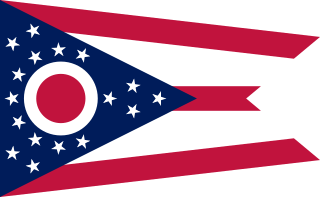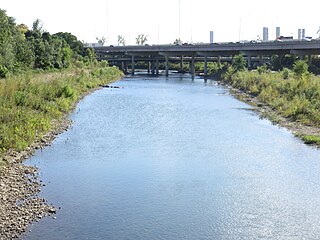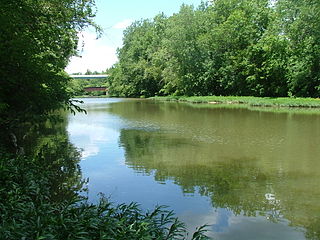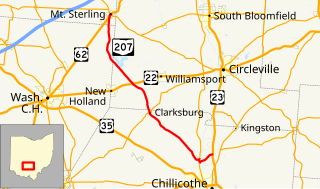Kinnikinnick Creek is a shallow waterway that is part of the Scioto River watershed, flowing through southern Pickaway and northern Ross Counties in Ohio. The area through which the creek flows, which includes the villages of Wisler, Kingston and Kinnikinnick, Ohio is known locally as the Kinnikinnick Prairie.

The Scioto River is a river in central and southern Ohio more than 231 miles (372 km) in length. It rises in Auglaize County in west central Ohio, flows through Columbus, Ohio, where it collects its largest tributary, the Olentangy River, and meets the Ohio River at Portsmouth. Early settlers and Native Americans used the river for shipping but it is now too small for modern commercial shipping. The primary economic importance for the river now is for recreation and drinking water. It is the longest river that is entirely within Ohio.

Ohio is a Midwestern state in the Great Lakes region of the United States. Of the fifty states, it is the 34th largest by area, the seventh most populous, and the tenth most densely populated. The state's capital and largest city is Columbus.

Kingston is a village in Ross County, Ohio, United States. The population was 1,032 at the 2010 census.
Contents
The Kinnikinnick has two branches, the main (north) branch, and the south branch. The creek’s northern headwaters form near the Pickaway County village of Leistville, Ohio, and flow south to the confluence of the creek’s southern branch, which has its head waters in Ross County. There, the creek begins its west-southwest path until it merges with the Scioto River north of the city of Chillicothe, Ohio.

Pickaway County is a county located in the U.S. state of Ohio. As of the 2010 census, the population was 55,698. Its county seat is Circleville. Its name derives from the Pekowi band of Shawnee Indians, who inhabited the area.

Ross County is a county located in the Appalachian region of the U.S. state of Ohio. As of the 2010 census, the population was 78,064. Its county seat is Chillicothe, the first and third capital of Ohio. Established on August 20, 1798, the county is named for Federalist Senator James Ross of Pennsylvania.

Chillicothe is a city in and the county seat of Ross County, Ohio, United States. Located along the Scioto River 45 miles south of Columbus, Chillicothe was the first and third capital of Ohio.
The creek was named for the Native American tobacco product kinnikinnick. [1] The creek was a resource for Native Americans in the days before European Settlement. When white settlers moved into the region around 1800, Kinnikinnick was a significant source of fresh water for consumption, and crop irrigation.
Kinnikinnick is a Native American and First Nations herbal smoking mixture, made from a traditional combination of leaves or barks. Recipes for the mixture vary, as do the uses, from social, to spiritual to medicinal.

Water is a transparent, tasteless, odorless, and nearly colorless chemical substance, which is the main constituent of Earth's streams, lakes, and oceans, and the fluids of most living organisms. It is vital for all known forms of life, even though it provides no calories or organic nutrients. Its chemical formula is H2O, meaning that each of its molecules contains one oxygen and two hydrogen atoms, connected by covalent bonds. Water is the name of the liquid state of H2O at standard ambient temperature and pressure. It forms precipitation in the form of rain and aerosols in the form of fog. Clouds are formed from suspended droplets of water and ice, its solid state. When finely divided, crystalline ice may precipitate in the form of snow. The gaseous state of water is steam or water vapor. Water moves continually through the water cycle of evaporation, transpiration (evapotranspiration), condensation, precipitation, and runoff, usually reaching the sea.

Irrigation is the application of controlled amounts of water to plants at needed intervals. Irrigation helps to grow agricultural crops, maintain landscapes, and revegetate disturbed soils in dry areas and during periods of less than average rainfall. Irrigation also has other uses in crop production, including frost protection, suppressing weed growth in grain fields and preventing soil consolidation. In contrast, agriculture that relies only on direct rainfall is referred to as rain-fed or dry land farming.
The Kinnikinnick is considered a major waterway feeder for the Scioto River by The Ohio State University Extension Services. Portions are navigable by canoe.














